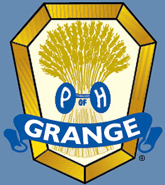| |
 |
|
| |
|
 |
Witch Hazel, Connecticut’s forgotten agricultural product |
| |
By Carol Davidge - “The Reminder” |
| |
MAY 2007 -- VOLUNTOWN - For four generations, the Michaels in the Dzurnak family of Sterling have harvested witch hazel in Pachaug State Forest.
“My grandfather, Michael Dzurnak, came up from Pennsylvania in the 1920s” said the third Michael, now semi-retired. (Michael is a 26 year member of Ekonk Community Grange).
“My father - Michael, Jr.- was born in 1910 in Taylor, Pennsylvania, and was 10 years old when the family came to Sterling.” The original Michael Dzurnak bought a 200-acre dairy farm, where Michael’s mother Mary, now 84, still lives.
New England witch hazel (Hamamelis vrginiania) is native to America. It blooms in the late fall with frizzly looking yellow flowers. It is a shrub that can be cut to the ground every year because it will re-sprout the following spring.
New England native Americans boiled the woody plant in water to create an extract that was used for medicinal purposes, such as cuts, muscle aches and insect bites. The native Americans introduced witch hazel to the European colonists in the 1600s.
The name “witch” hazel may have several origins. Branches of Witch Hazel were used by farmers as “witching sticks” for dowsing to find water.
The name may also have derived from an old English word “wych” meaning “pliable branches.”
In England, during American colonization, dowsing sticks were taken from an elm known as a “witch hazel,” so colonists may have transferred that name to the American bush, according to botanist Steven Foster.
Today, witch hazel is used around the world in numerous products from high-end cosmetics to deodorants and health care products.
It is also sold as an astringent for facial cleansing. As much as 99 percent of the world’s witch hazel is produced in Connecticut by American Distilling & Manufacturing Company of East Hampton.
“More witch hazel is used than any other botanical product in the world,” according to American Distilling’s home page.
The history of one of America’s oldest family brands - Dickinson witch hazel - goes back to the 1870’s, when Thomas N. Dickinson, Sr. began producing witch hazel in Essex.
His sons, T.N. Dickinson, Jr. and Everett Dickinson, created two different companies - the T.N. Dickinson company in East Haddam and the E.E. Dickinson company in Essex.
In drugstores today you can still find products with the E.E. Dickinson and T.N. Dickinson brands, but between 1970 and 1995, both companies merged with American Distilling.
The first Michael Dzurnak began to harvest witch hazel as a winter activity, and his son, grandson and great-grandsons have continued the tradition.
“We’re called bushhogs,” said the semi-retired Dzurnak.
When weather permits, Dzurnak and longtime friends Russell Galas of Dudley, Mass., and Teddy Lapointe of Sterling make the trek to Voluntown.
Asked how he can identify witch hazel in winter when there are no leaves on the branches, he said he’s been doing it since he was a kid.
“I can just tell,” said Dzurnak, who adds that witch hazel bushes sprout in late April or May. “It comes up with the skunk cabbage and cowslip,” he said.
While his grandfather used draft horses to bring the brush out of the woods, today’s Dzurnak uses a tractor.
After the recent sleet storm, he sledded the brush out of Pachaug. Then he put the brush through a wood chipper and took the chips to American Distilling. Dzurnak has a permit from the Connecticut DEP, and he has harvested as many as 300 tons of witch hazel every year.
All varieties of witch hazel have the frizzly yellow flowers, but they bloom at different times. the other native, Hamemeli vernalis, grows in the Ozarks and blooms in early winter; Asian varieties bloom in early spring: Hamamelis japonica, Hamamelis mollis, and Hamamelis x intermedia.
If you’re in the woods in late fall and see a witch hazel blooming, watch the flowers. Sometimes the seeds explode out of the blossoms.
|
| |
|
|
|
|
 |
|
 |
| |
|
